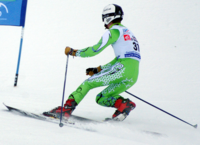Nordic skier

Telemark skiing competition
|
|
| Characteristics | |
|---|---|
| Type | outdoors |
| Equipment | skis, skipoles |
| Presence | |
| Olympic | 1924 – present |
| Paralympic | 1976 – present |
Nordic skiing pertains to skiing disciplines that use equipment where the toe of the ski boot is fixed to the binding in a manner that allows the heel to rise off the ski, unlike Alpine skiing, where the boot is attached to the ski from toe to heel. Recreational disciplines include cross-country skiing and Telemark skiing.
Olympic events are cross-country skiing, ski jumping and nordic combined—competition in which athletes both cross-country ski and ski jump. The FIS Nordic World Ski Championships host these sports, plus Telemark skiing, at the championship level in the winter of every odd numbered year.Biathlon combines cross-country skiing and rifle shooting, but is not included as a Nordic discipline under FIS rules. Instead, it is under the jurisdiction of the International Biathlon Union.
The biomechanics of competitive cross-country skiing and ski jumping have been the subject of serious study. Cross-country skiing requires strength and endurance and ski jumping requires aerodynamic efficiency, both of which requirements translate into specific skills to be optimized in training and competition.
Wilderness cross-country skiing in Alaska.
Back-country telemark skiing in France
Anna Haag in the women's 10 km classic race at the 2011 FIS Nordic World Ski Championships in Oslo, Norway.
Jurij Tepeš during team competition of FIS Ski-Flying World Championships 2012 in Vikersund, Norway.
...
Wikipedia
